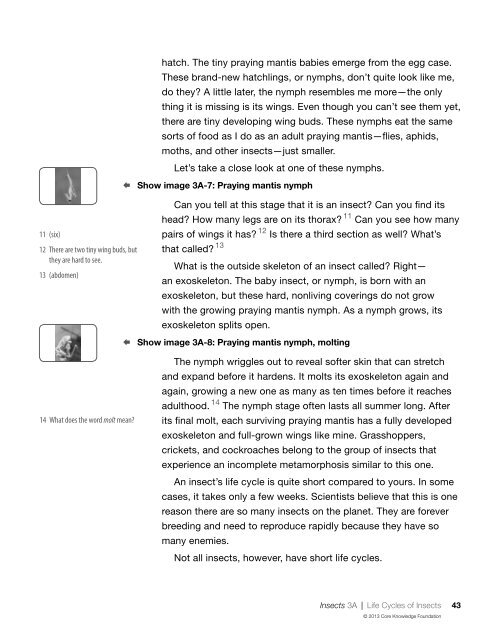Read-Aloud Anthology - EngageNY
Read-Aloud Anthology - EngageNY
Read-Aloud Anthology - EngageNY
Create successful ePaper yourself
Turn your PDF publications into a flip-book with our unique Google optimized e-Paper software.
hatch. The tiny praying mantis babies emerge from the egg case.<br />
These brand-new hatchlings, or nymphs, don’t quite look like me,<br />
do they? A little later, the nymph resembles me more—the only<br />
thing it is missing is its wings. Even though you can’t see them yet,<br />
there are tiny developing wing buds. These nymphs eat the same<br />
sorts of food as I do as an adult praying mantis—flies, aphids,<br />
moths, and other insects—just smaller.<br />
Let’s take a close look at one of these nymphs.<br />
Show image 3A-7: Praying mantis nymph<br />
11 (six)<br />
12 There are two tiny wing buds, but<br />
they are hard to see.<br />
13 (abdomen)<br />
Can you tell at this stage that it is an insect? Can you find its<br />
head? How many legs are on its thorax? 11 Can you see how many<br />
pairs of wings it has? 12 Is there a third section as well? What’s<br />
that called? 13<br />
What is the outside skeleton of an insect called? Right—<br />
an exoskeleton. The baby insect, or nymph, is born with an<br />
exoskeleton, but these hard, nonliving coverings do not grow<br />
with the growing praying mantis nymph. As a nymph grows, its<br />
exoskeleton splits open.<br />
Show image 3A-8: Praying mantis nymph, molting<br />
14 What does the word molt mean?<br />
The nymph wriggles out to reveal softer skin that can stretch<br />
and expand before it hardens. It molts its exoskeleton again and<br />
again, growing a new one as many as ten times before it reaches<br />
adulthood. 14 The nymph stage often lasts all summer long. After<br />
its final molt, each surviving praying mantis has a fully developed<br />
exoskeleton and full-grown wings like mine. Grasshoppers,<br />
crickets, and cockroaches belong to the group of insects that<br />
experience an incomplete metamorphosis similar to this one.<br />
An insect’s life cycle is quite short compared to yours. In some<br />
cases, it takes only a few weeks. Scientists believe that this is one<br />
reason there are so many insects on the planet. They are forever<br />
breeding and need to reproduce rapidly because they have so<br />
many enemies.<br />
Not all insects, however, have short life cycles.<br />
Insects 3A | Life Cycles of Insects 43<br />
© 2013 Core Knowledge Foundation

















